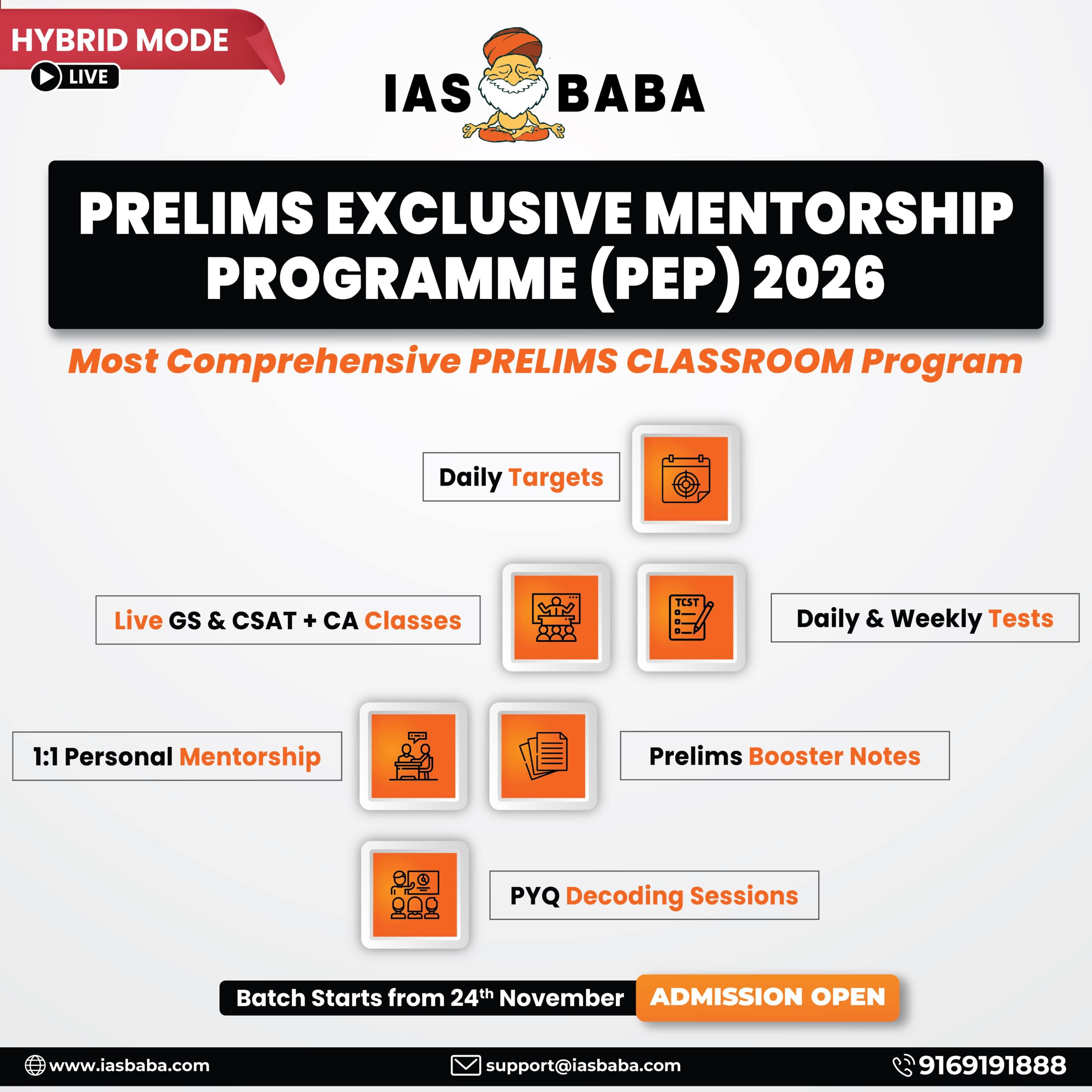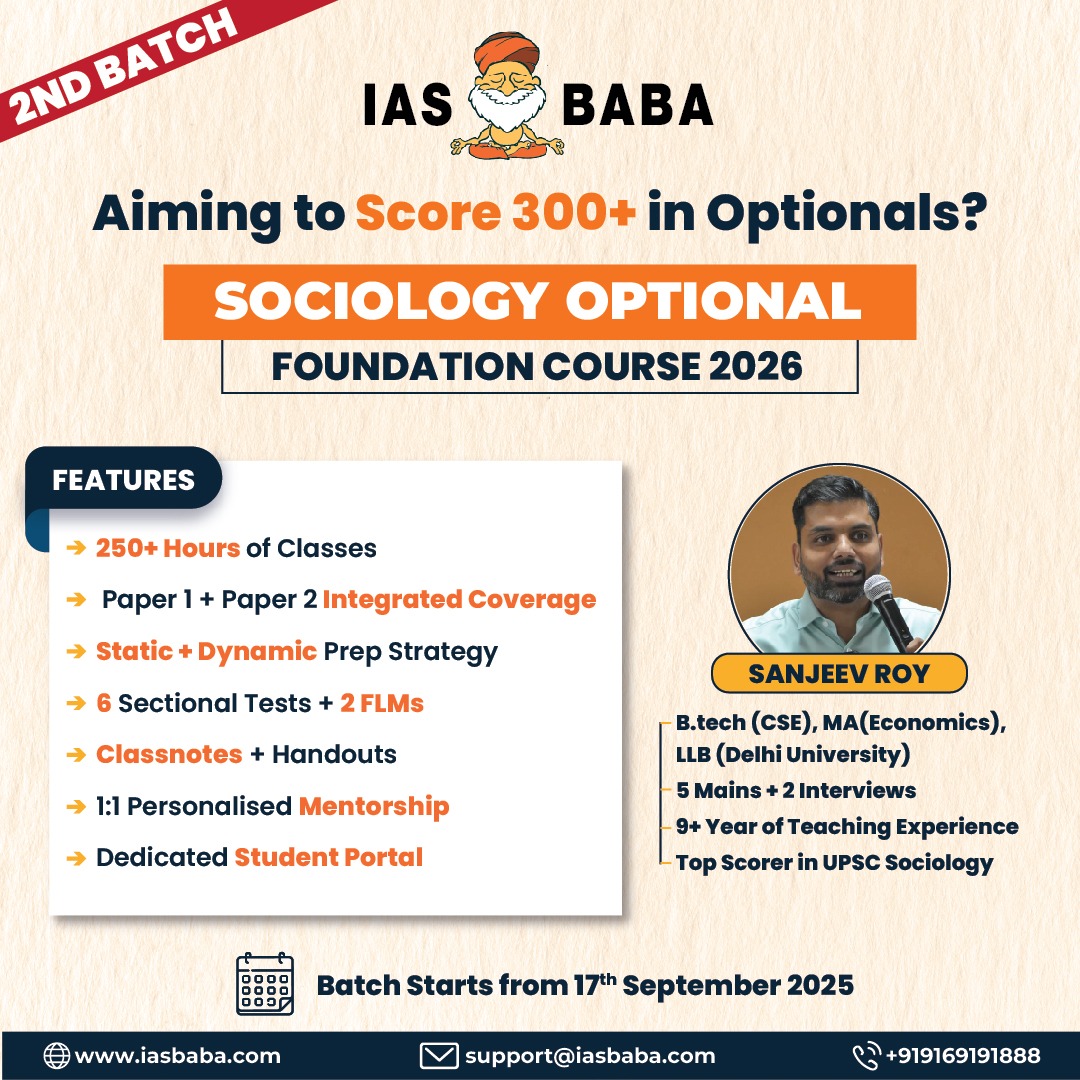IASbaba's Daily Current Affairs Analysis
Archives
(PRELIMS Focus)
Category: INTERNATIONAL
Context: Wassenaar Arrangement in governing modern digital technologies and argues for reforming export control regimes to address challenges posed by cloud services, AI, and surveillance tools.
- Modern Internet dependence: Cloud infrastructure, dominated by few companies like Microsoft, is crucial for states but can also aid repression (e.g., in Palestine).
- Export control regimes: Agreements like the Wassenaar Arrangement aim to regulate export of sensitive goods and dual-use technologies to prevent misuse.
- Limitations of current framework:
- Focused mainly on physical exports (devices, chips, hardware).
- Struggles to regulate cloud services, APIs, and remotely accessed technologies.
- Leaves loopholes for “intrusion software” and surveillance misuse.
- India’s role: Joined in 2017, regularly updates control lists but faces challenges in ensuring compliance.
- Reform needs:
- Expand definitions to cover remote access, cloud exports, and digital surveillance.
- Introduce binding global treaties with clearer licensing and oversight.
- Create domain-specific controls for AI and high-risk digital tools.
- Global implications:
- Divergent national licensing can create loopholes.
- Stronger coordination needed to prevent misuse across borders.
- Possible measures:
- Tighter export scrutiny for cloud services.
- Binding international commitments.
- Technical expert committees to guide regulation.
- Conclusion: Existing arrangements are outdated; comprehensive reforms are essential to regulate 21st-century technologies without stifling innovation.
Learning Corner:
Wassenaar Arrangement (WA)
- Nature: A multilateral export control regime for conventional arms and dual-use goods and technologies.
- Established: 1996, in Wassenaar, Netherlands.
- Objective:
- To promote transparency and responsibility in transfers of arms and sensitive technologies.
- To prevent destabilising accumulations of weapons and technologies that could aid in proliferation or repression.
- Membership: 42 participating states (as of 2025), including India, the U.S., most EU states, Japan, etc.
- India’s membership: Joined in December 2017.
- Mechanism:
- States exchange information on transfers/denials of items listed in WA control lists.
- It is non-binding; decisions on licensing remain at the discretion of each state.
- Scope:
- Covers conventional arms.
- Covers dual-use goods and technologies (civilian use but potential military/security application).
- In 2013, scope expanded to include “intrusion software” and surveillance technologies.
- Challenges:
- Primarily designed for physical goods, struggles to regulate cloud services, AI, and remote-access technologies.
- Implementation uneven across members; often influenced by political and commercial interests.
Source: THE HINDU
Category: ECONOMICS
Context : India’s Index of Industrial Production (IIP) grew by 4.0% in August 2025, showing broad-based recovery in industrial activity.
- IIP growth accelerated from 3.5% in July 2025 to 4.0% in August.
- Mining output rose sharply by 6.0%, rebounding from contraction.
- Manufacturing grew 3.8%, led by basic metals (12.2%), motor vehicles (9.8%), and petroleum products (5.4%).
- Electricity generation increased by 4.1%.
- Use-based growth:
- Infrastructure/Construction Goods: +10.6% (highest).
- Primary Goods: +5.2%, Intermediate Goods: +5.0%, Capital Goods: +4.4%.
- Consumer Durables: +3.5%; Consumer Non-durables: –6.3% (weak demand).
- Growth driven by post-monsoon mining recovery, strong demand in metals, vehicles, and construction activity.
Learning Corner:
Index of Industrial Production (IIP)
- Definition:
- The IIP measures the volume of production of a basket of industrial products in the economy.
- It serves as a short-term indicator of industrial growth.
- Base Year:
- Current base year: 2011–12 (revised periodically to reflect structural changes).
- Released by:
- National Statistical Office (NSO), Ministry of Statistics and Programme Implementation (MoSPI).
- Released monthly with a time lag of about six weeks.
- Coverage:
- Divided into 3 major sectors:
- Mining (14.4% weight)
- Manufacturing (77.6% weight – largest share)
- Electricity (8.0% weight)
- Further classified into Use-based categories: Primary Goods, Capital Goods, Intermediate Goods, Infrastructure/Construction Goods, Consumer Durables, and Consumer Non-durables.
- Divided into 3 major sectors:
- Significance:
- Acts as a proxy for industrial activity and short-term economic performance.
- Influences monetary policy (RBI monitors it for inflation and growth signals).
- Used by businesses, analysts, and policymakers for planning and forecasting.
- Limitations:
- Provisional data, often revised later.
- Limited coverage compared to GDP or GVA.
- Heavily manufacturing-driven, may not fully capture services-led growth in India’s economy.
Core Industries
- Definition:
- The Core Industries are the eight key industries of India that form the backbone of the economy and have a high impact on overall industrial growth.
- They have a combined weight of 40.27% in the Index of Industrial Production (IIP).
- The Eight Core Industries (with weights in IIP):
- Coal – 10.33%
- Crude Oil – 8.98%
- Natural Gas – 6.88%
- Refinery Products – 28.04% (highest weight)
- Fertilizers – 2.63%
- Steel – 17.92%
- Cement – 5.37%
- Electricity – 19.85%
- Released by:
- Office of Economic Adviser (OEA), Department for Promotion of Industry and Internal Trade (DPIIT), Ministry of Commerce and Industry.
- Released monthly, usually at the end of the following month.
- Significance:
- Acts as a lead indicator of industrial performance and overall GDP trends.
- Closely tracked by policymakers, RBI, and businesses to gauge economic health.
- Growth or slowdown in these industries directly affects related sectors (e.g., steel impacts construction, coal impacts power generation).
Source: PIB
Category: SCIENCE AND TECHNOLOGY
Context: IISc has developed a siphon-powered desalination technology that converts saltwater into clean drinking water more efficiently than conventional solar stills.
- Uses a fabric wick with a grooved metal surface to create a siphon, moving salty water onto a heated surface.
- Continuous flushing prevents salt crystallization, avoiding blockages common in older designs.
- Water evaporates as a thin film and condenses just 2 mm away, enhancing efficiency.
- Modular design allows stacking multiple units, recycling heat for higher output.
- Produces over six liters of potable water per sq. meter per hour, much higher than standard solar stills.
- Handles high salinity (up to 20% salt) without clogging.
- Built with low-cost materials like aluminum and fabric; powered by solar or waste heat.
- Suitable for off-grid villages, disaster zones, and arid coastal areas.
- Represents a scalable, sustainable, and affordable solution for global water security.
Learning Corner:
Siphon Principle
- Definition:
A siphon is a device that allows liquid to flow from a higher level to a lower level through a tube, even if the tube rises above the surface of the liquid in the higher container. - Working Principle:
- Relies on gravity and the difference in liquid pressure at the two ends of the tube.
- Once the tube is filled, the liquid continues to flow because the pressure at the lower outlet is less than at the higher source.
- The liquid column in the descending limb (heavier) pulls the liquid up the ascending limb.
- Key Conditions:
- Outlet must be below the liquid surface of the source container.
- The tube must be primed (filled with liquid) initially.
- Works only until the source liquid level drops below the inlet end.
- Applications:
- Emptying tanks, aquariums, and fuel tanks.
- Irrigation and drainage systems.
- Some modern technologies (like IISc’s desalination system) use siphon action for fluid movement.
Source: PIB
Category: POLITY
Context The “Convergence for Viksit Bharat 2047: Industry Conclave on Skilling & Employment” was organized by the Ministry of Minority Affairs under the PM VIKAS scheme in New Delhi to boost inclusive development.
- Organized with support from Delhi Sikh Gurdwara Management Committee and State Institute of Hotel Management, Tripura.
- Union MoS for Minority Affairs, George Kurian, attended the conclave.
- Industry participation from 11 sectors including healthcare, aviation, electronics, tourism, and hospitality.
- Two MoUs signed:
- Ministry of Minority Affairs + DSGMC + Wadhwani Foundation
- DSGMC + SIHM Tripura
- Focus on convergence of government schemes, industry needs, and emerging technologies in skilling.
- Panel discussion stressed industry-ready, globally mobile workforce, apprenticeships, and new job roles.
- PM VIKAS scheme: blends modern skills with traditional expertise; 41 projects in 30 States/UTs, benefiting 1.34 lakh youth and artisans.
- Conclave urged industry’s role in curriculum design, apprenticeships, and placements.
- Part of Viksit Bharat 2047 vision to achieve a developed, competitive India by centenary of independence.
Learning Corner:
PM VIKAS (Pradhan Mantri Virasat Ka Samvardhan)
- Ministry: Implemented by the Ministry of Minority Affairs.
- Launch: Announced in 2022–23 Union Budget as an umbrella scheme.
- Objective:
- To integrate modern skill training with India’s traditional expertise.
- Provide end-to-end support for education, skilling, entrepreneurship, and credit linkages to minority and marginalized communities.
- Key Features:
- Combines skill development with preservation of artisanal crafts and heritage trades.
- Offers credit assistance, training, market linkages, and digital empowerment.
- Focus on youth, women, and artisans from minority communities.
- Impact (till 2025):
- 41 projects rolled out across 30 States/UTs.
- Benefited 1.34 lakh youths and artisans through transparent and efficient processes.
- Significance:
- Enhances employability and self-reliance of minority youth.
- Supports the vision of Viksit Bharat 2047, aligning skilling with livelihoods and dignified employment.
Source: PIB
Category: ENVIRONMENT
Context The National Biodiversity Authority (NBA) has sanctioned ₹82 lakh to the Andhra Pradesh Biodiversity Board for conserving the endangered Red Sanders tree under the Access and Benefit Sharing (ABS) mechanism.
- Objective: Raise 1 lakh Red Sanders saplings for farmers under the Trees Outside Forests (ToF) program.
- ABS Mechanism: Funded through benefit-sharing contributions from enterprises using Red Sanders.
- Community Involvement: Local and tribal communities, Biodiversity Management Committees, and stakeholders engaged in nursery, plantation, and care.
- Geographic Focus: Native to Southern Eastern Ghats (Anantapur, Chittoor, Kadapa, Kurnool).
- Protection Status: Endangered, threatened by smuggling; protected under Wildlife Protection Act, 1972, and listed under CITES.
- Impact: Generates rural employment, skills, and sustainable livelihoods while strengthening conservation.
- Past Efforts: NBA has already provided ₹31.55 crore to Andhra Pradesh’s forest department for enforcement and protection.
- Significance: Supports India’s biodiversity targets and global commitments under the Convention on Biological Diversity (CBD).
Learning Corner:
National Biodiversity Authority (NBA)
- Establishment:
- Set up in 2003 under the Biological Diversity Act, 2002.
- Headquarters:
- Located in Chennai, Tamil Nadu.
- Nature:
- A statutory autonomous body under the Ministry of Environment, Forest and Climate Change (MoEFCC).
- Functions:
- Regulates access to biological resources and associated traditional knowledge.
- Ensures fair and equitable benefit-sharing (ABS) arising from the use of biological resources.
- Issues approvals for research, commercial use, IPRs, and technology transfer involving India’s biodiversity.
- Advises the Central and State Governments on matters related to biodiversity conservation and sustainable use.
- Supports State Biodiversity Boards (SBBs) and Biodiversity Management Committees (BMCs) at local levels.
- Key Role in Conservation:
- Implements provisions of the Convention on Biological Diversity (CBD) at the national level.
- Promotes People’s Biodiversity Registers (PBRs) to document local biological resources and knowledge.
- Facilitates community participation in conservation and livelihood generation.
Red Sanders (Pterocarpus santalinus)
- Description:
- A rare and highly valued endemic tree species known for its distinctive red-colored heartwood.
- Belongs to the family Fabaceae.
- Geographic Range:
- Found mainly in the Southern Eastern Ghats, particularly in the districts of Chittoor, Kadapa, Anantapur, and Kurnool in Andhra Pradesh.
- Uses & Value:
- Heartwood is used in fine furniture, medicinal preparations, musical instruments, and as a dye.
- High international demand makes it one of the most smuggled tree species from India.
- Threats:
- Over-exploitation and smuggling due to high market value.
- Habitat loss and degradation.
- Protection Status:
- IUCN Red List: Endangered.
- CITES: Appendix II (international trade regulated).
- Wildlife Protection Act, 1972: Listed under Schedule IV.
- Conservation Efforts:
- National Biodiversity Authority (NBA) funds conservation under the Access and Benefit Sharing (ABS) mechanism.
- Plantation programs and community participation promoted under Trees Outside Forests (ToF) initiatives.
- Enforcement measures by Andhra Pradesh Forest Department to curb illegal felling and smuggling.
Source: PIB
(MAINS Focus)
Introduction (Context)
The modern Internet relies on extensive computing backbones controlled by a few global technology companies Among these, Microsoft plays a critical role, providing indispensable services to governments worldwide.
However, the use of such infrastructure in contexts like Israel’s repression of Palestinians highlights a key challenge of existing export control regimes struggle to regulate digital services and cloud-based technologies, which were not envisioned when the rules were originally drafted.
What are export control regimes?
- Export regimes are international agreements between supplier countries to control the export of sensitive goods and technologies to prevent the proliferation of weapons of mass destruction.
Purpose:
- Prevent the proliferation of weapons of mass destruction (WMDs).
- Control the transfer of dual-use technologies that can be misused for military or surveillance purposes.
- Ensure global security, stability, and responsible use of advanced technologies.
- Countries maintain control lists, licensing procedures, and information-sharing frameworks while implementing rules domestically.
What is the Wassenaar Arrangement?
- It is a multilateral export control regime for conventional arms and dual-use goods and technologies.
- Participating states commit to sharing information, maintaining control lists, and regulating exports while retaining discretion on national licensing and enforcement.
- In 2013, the Arrangement expanded to include controls on “intrusion software”, that is, software designed to bypass or defeat security protections of networks and certain surveillance or cyber-surveillance systems.
Present Issues
- The Arrangement was made when only physical items like devices, chips, and hardware were controlled. Software was not taken seriously.
- Many activities in cloud computing are unclear under the rules:
-
- Using or managing software remotely may not count as an “export.”
- Different countries understand technology transfer in different ways.
- In Software-as-a-Service, users access software over the internet without installing it. The rules cannot clearly say if this is an export.
- Any country in the Arrangement can block changes, making updates slow.
- Each country follows its own export rules, which may be weak or inconsistent.
- Loopholes exist for safe research or transferring technology within a country.
India and the Wassenaar Arrangement
- India became a Wassenaar Arrangement participant in 2017.
- Incorporated Wassenaar Arrangement control lists into its SCOMET (Special Chemicals, Organisms, Materials, Equipment, and Technologies) framework.
- Engagement has largely been about gaining legitimacy in global export-control regimes, rather than driving reforms for the digital era.
Reforms Needed
Expand Scope:
- Include technologies and services that enable large-scale surveillance, profiling, discrimination, or cross-border control.
- Example: Regional biometric systems or policing-related data transfers.
- Clearly define capacity limits and allow safe, defensive uses under strict rules.
Redefine ‘Export’:
- Treat remote access, administration, or API calls in cloud systems as exports.
- Include end-use controls considering the user, country, legal mandate, and risk of misuse.
- Focus not just on military risks but also human rights risks from digital surveillance.
Make it Binding:
- Move from voluntary participation to a binding treaty with Minimum licensing standards, Export bans in high-risk regions and Peer-review supervision.
Global Coordination:
- Share information and align policies across countries.
- Maintain shared watchlists and real-time alerts for flagged users or entities.
- Include technical standards for cross-border interoperability.
Agility for Fast-Moving Technology:
- Set up a technical committee or secretariat for quick updates and expert inputs.
- Introduce a sunset mechanism so technologies leave the control list unless renewed.
- Consider domain-specific regimes for AI, cyber weapons, and digital surveillance that can evolve faster than the main framework.
Conclusion
The Wassenaar Arrangement remains important for global export control but faces gaps in regulating cloud services, SaaS, AI, and digital surveillance technologies. Reforms are needed to expand scope, redefine export, enforce binding obligations, coordinate globally, and remain agile.
Mains Practice Question
Q Examine the challenges faced by the Wassenaar Arrangement in regulating modern digital technologies. Suggest reforms to make it effective in the era of cloud computing and AI. (250 words, 15 marks)
Source: The Wassenaar Arrangement: the need to reform export control regimes – The Hindu
Introduction (Context)
The Central Pollution Control Board (CPCB) has recently reported stretches of the Ganga where water quality has deteriorated despite decades of policy interventions and heavy financial investments. The report highlights the urgency of protecting the ecological balance of the Ganga basin, which sustains nearly half of India’s population.
About Ganga River
- The Ganga is India’s longest river and holds immense cultural, economic, and spiritual significance.
Origin and tributaries
- The Ganga originates when the Bhagirathi from the Gangotri glacier and the Alaknanda merge at Devprayag.
- It enters the plains near Haridwar and flows about 2,525 km before reaching the Bay of Bengal.
- Major right-bank tributaries are the Yamuna and Son.
- Major left-bank tributaries include Ramganga, Kali, Gomti, Ghaghra, Gandak, and Kosi.
- After crossing the Farakka Barrage, the river splits into the Hooghly in India and the Padma in Bangladesh.
Ganga Basin
- The basin can be divided into three stretches:
-
- Upper Ganga Basin: From the origin to Narora Barrage.
- Middle Ganga Basin: From the Narora Barrage to Ballia District, Uttar Pradesh.
- Lower Ganga Plain: From Ballia to the Bay of Bengal.
- The middle and lower Ganga basins have the highest population densities with major urban centers like Lucknow, Kanpur, Allahabad, Varanasi and Patna.
Key characteristics
- It is India’s longest river with its basin spreading to around 27 per cent of the land mass and sustaining nearly 47 per cent of the population
- Spanning about 10.86 lakh sq. km across India, Nepal, Tibet (China), and Bangladesh.
- About 80 per cent of this basin area (8,61,452 sq km) lies in India, covering more than one-fourth (approximately 27 per cent) of the country’s total geographical area.
- The basin extends across 11 Indian states: Uttarakhand, Uttar Pradesh, Delhi, Haryana, Rajasthan, Madhya Pradesh, Bihar, Jharkhand, Chhattisgarh and West Bengal.
- Average density in the basin is around 520 persons/sq. km, with some regions like Delhi (11,297), Bihar (1,102), and West Bengal (1,029) far exceeding the national average.
- Over 65% of the basin is used for agriculture, supported by fertile alluvial soils and extensive irrigation networks.
- Estimated surface and sub-surface water potential of 525.02 BCM, with groundwater supporting nearly 50% of India’s total groundwater-irrigated area.
- The Ganga basin contains 784 dams, with Madhya Pradesh having the highest number (364), followed by Rajasthan (145) and Uttar Pradesh (98).
- Tehri Dam is the tallest at 260.5 meters, while Nanak Sagar Dam is the longest at 19.2 km
- There are 478 major and medium irrigation projects and 39 hydro-electric projects across the basin.
- The basin’s groundwater resources support nearly 50% of India’s total groundwater-irrigated area, making it crucial for agriculture and water security.
Issues
- World Bank assessments indicate that roughly 2,700 million litres of wastewater are released into the Ganga basin every day.
- The Middle Ganga stretch records the highest pollution levels, receiving nearly 500 million litres of industrial effluents daily.
- Groundwater in several basin states shows contamination with arsenic, fluoride, iron, nitrate, and chloride, posing serious health risks.
- Heavy dependence on monsoon rainfall (June–September) causes sharp variations in river discharge and triggers recurring floods, especially in Uttar Pradesh, Bihar, and West Bengal.
- Intense population pressure and rapid urban growth have overstrained the basin’s land and water resources.
- Irregular rainfall patterns and melting glaciers further endanger the region’s long-term water security.
Government initiatives
- Ganga Action Plan (GAP-I & II) was launched in 1985 and 1993 to reduce pollution in 25 major towns.
- National Ganga River Basin Authority (2009) for formed for coordinated planning and monitoring.
- Namami Gange (2014) Flagship mission targeting Aviral Dhara (continuous flow) and Nirmal Dhara (unpolluted flow) with focus on ecological integrity and community participation was launched.
Despite these efforts, outcomes remain limited due to fragmented governance, weak enforcement, and lack of incentive-based mechanisms.
Way forward
- Shift focus from reactive pollution control to proactive ecosystem management.
- Develop incentive-based policies linking conservation to socio-economic benefits.
- Strengthen real-time monitoring, wastewater treatment, and industrial effluent management.
- Promote community participation, traditional water wisdom, and behavioural change campaigns.
- Integrate cutting-edge technology for river rejuvenation, including AI-based pollution tracking and climate-resilient planning.
Conclusion
The Ganga (India’s sacred lifeline), is under unprecedented ecological stress from pollution, population pressure, and over-exploitation of land and water resources.
Future sustainability demands a paradigm shift balancing developmental needs with basin-wide conservation, strict governance, and active citizen engagement to ensure the river’s Aviral and Nirmal flow for generations to come.
Mains Practice Question
Q Why have government programmes like Namami Gange achieved limited success, and how can developmental needs be balanced with ecological restoration in the Ganga basin? (250 words, 15 marks)













